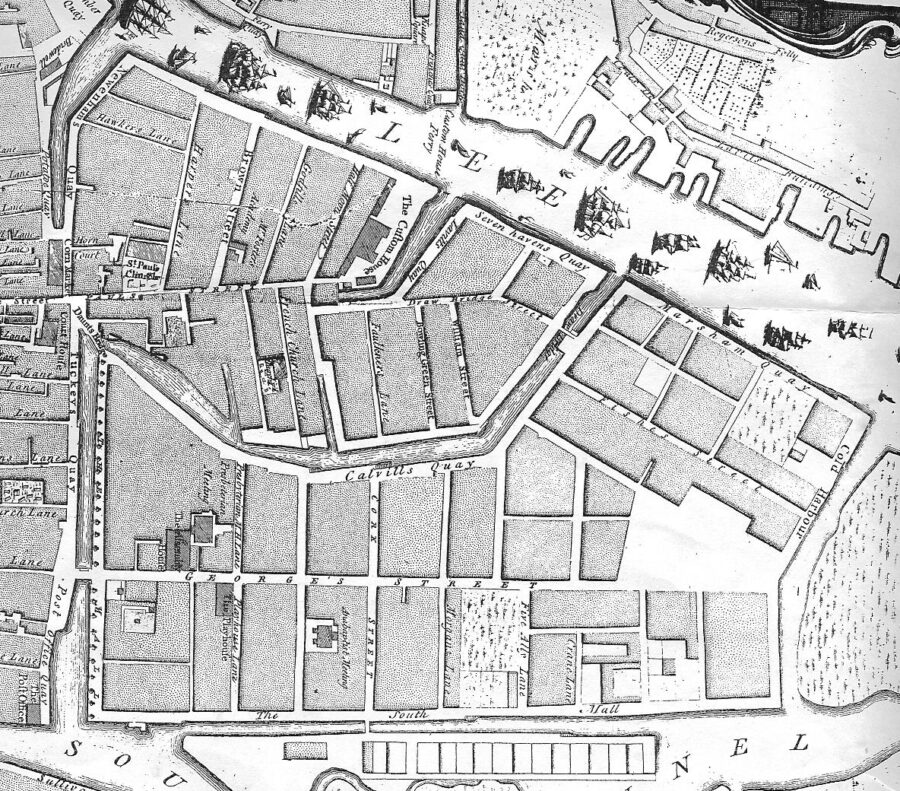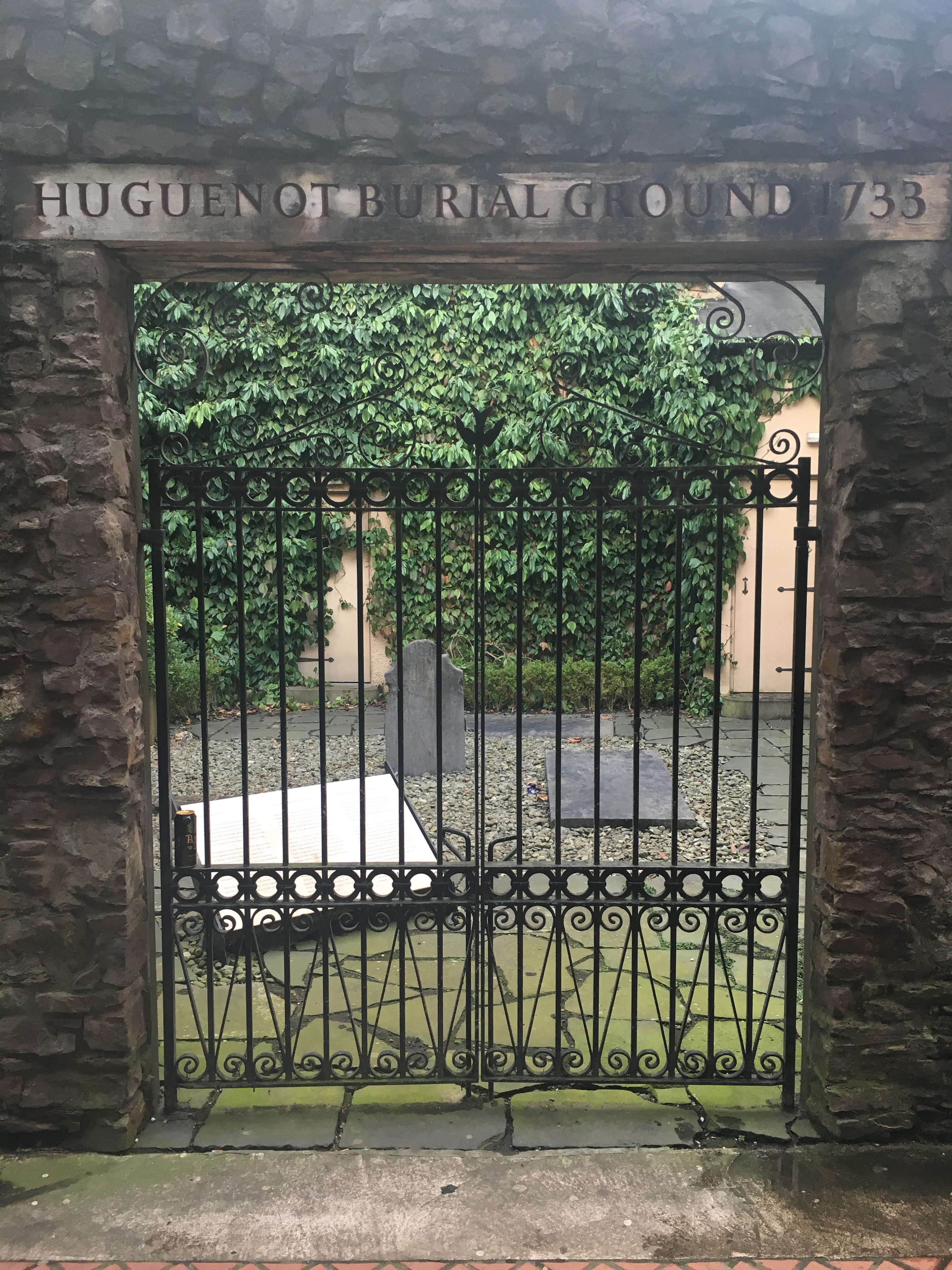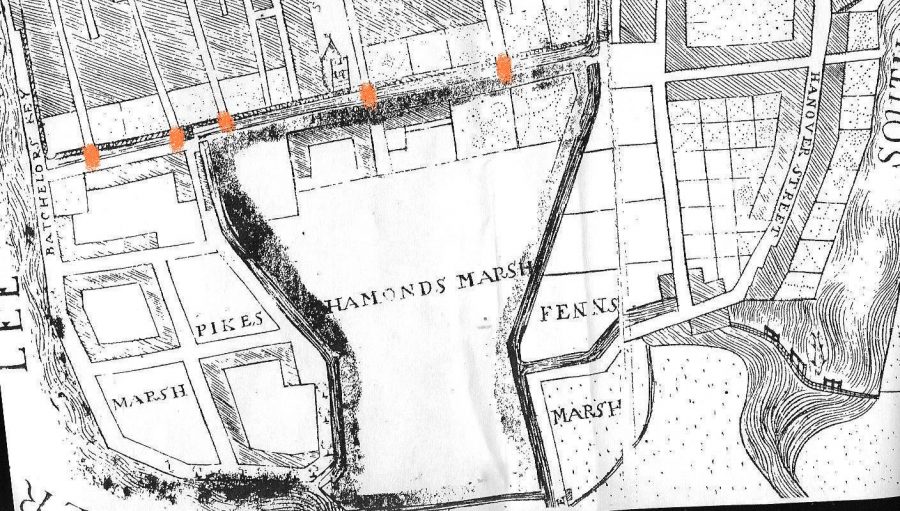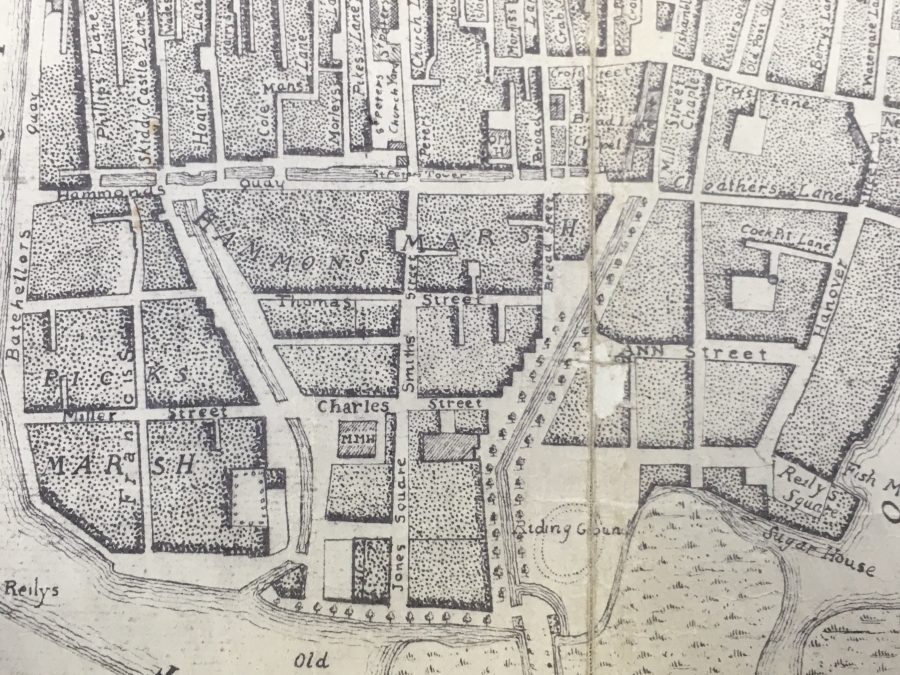
Legacies of the Huguenots:
The north eastern marshes became a significant area of development for the Huguenot congregation in Cork. By the mid 1700s in Cork, over three hundred Huguenots had established themselves in Cork city. Many of them worked as trade peoples especially in the textile industry and in the manufacture of linen and silk. The Huguenots were also involved in property development and one of the first Huguenot families to develop property was Joseph Lavitt whose family were primarily involved in overseas trade and sugar refining.
Lavitt’s Quay was constructed in 1704 and echoes the Huguenot’s past presence in the area. The areas of present day French Church Street, Carey’s Lane and Academy Street in the city centre today are located at the core of the Huguenot quarter with the name “French Church” also reflecting their involvement in townscape change in Cork in the early eighteenth century.
The growing Huguenot community in Cork initially worshipped in temporary locations but by 1712, members were able to build their own church or temple on Lunham Street, now French Church Street. In 1733 they acquired an adjoining almshouse, which they removed, using the area as a burial ground.
For just over a hundred years the Huguenots worshipped in French at their church. At first Calvinist (non-conformist) services were held, but by the 1740s, worship conformed to the Established Church (Anglican). By the early nineteenth century most Huguenot descendants no longer needed language services. Huguenot worship at the French Church ceased in about 1813.
The French Church was used for primitive Wesleyan Methodist worship for most of the nineteenth century. In 1845 the original building was replaced by a new larger chapel that extended from French Church Street to Carey’s Lane. From about 1901 the building was used for commercial purposes. The last known burial took place in that year.
This surviving portion of the burial ground has been preserved as a tribute to the Huguenots who made an important contribution to the life of Cork. It was acquired by Cork City Council in 2007 and transformed into a memorial garden during the following year. Two headstones had survived and when removing debris built over the years, archaeologists discovered other headstones and the remains of tombs. These marked the burying places of Huguenots and their descendants. Methodists also were interred here from the nineteenth century.
Unfortunately, the church and burial records have not survived. Some of those known to be buried here included members of the following Huguenot families – Goble, Hardy, Jappie, Le Grand, Madras, Malet, Perrier, and Pique. Protecting the burial ground from the street is an early eighteenth century wall, dating to the period when this area was settled.


Legacies of the Quakers:
To the west of the crumbling walled town, the religious group, the Quakers reclaimed and developed large portions of the marshy islands. This community had been in Cork since 1655, but it was only in the early 1700s that they were legally given the opportunity to develop their own lands. The Quaker movement began initially in Northern England circa 1650 and developed out of religious and political conflict. Also known as the Religious Society of Friends, they were a break away group from main-stream Protestantism. With the presence of massive opportunities for trade, the Quakers established themselves in Cork City and also in other Munster towns such as Bandon, Skibbereen, Charleville and Youghal.
One of the first Quaker pioneers in the development of the western marshes was Joseph Pike, who purchased marshy land in 1696, now the area of Grattan Street. Another key player was John Haman, a respected linen merchant who also owned land in the northern suburbs.
Minor players consisted of the Devonshire family, the Sleigh family and the Fenn family (Fenn’s Quay today marks their land). In the eastern marshes, a Quaker by the name of Captain Dunscombe bought land, now the area of the multi-storey car park on the Grand Parade and part of present day Oliver Plunkett Street.
One noted Quaker, William Penn spent much time in the Cork area. Born in 1644 in Tower Hill, London, William was the son of Admiral William Penn. Educated at Oxford, he was expelled for non-conformity, reputedly because of his contact with the Quaker movement. Subsequently, he went to France to study for two years at the Protestant University of Saumur, before returning to London to study law at Lincoln’s Inn. In the 1650s, Oliver Cromwell gave his father a considerable estate, the castle and manor of Macroom in County Cork.
On the accession of Charles II in the 1660s, he was dispossessed of this property and was compensated with lands in Shanagarry, County Cork. In 1667, his father, the admiral sent him to manage the estate. While in East Cork, he was influenced by his friend, a Quaker, Thomas Lee and converted to Quakerism.
In 1667, William visited the walled town of Cork in 1667 and attended a Quaker meeting. William Penn went on to become a well-known author of a large number of literary books and pamphlets, which supported Quaker doctrines and eventually emigrated to America where he was very instrumental in establishing the State of Pennsylvania, which was named after him
Explore a history trail of Cork’s old western marshes, now Grattan Street area, here:
Middle Parish History Trail | Cork Heritage


Read more and Explore more: 5a. A Cork & its Changing Townscape, Early 1800s | Cork Heritage
